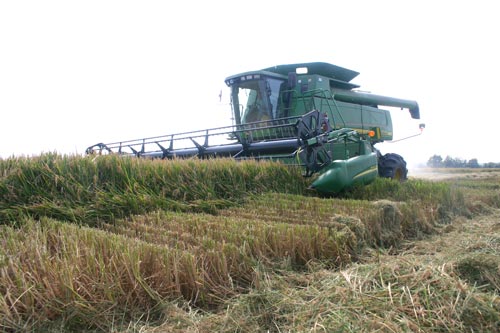
The Mid-South rice crop recorded the lowest milling yield on record, at 67.5 percent.The low milling yield and reduced overall yield in rice was due primarily to extremely hot weather in the Delta in the latter part of the summer.The low milling yield will affect the milling rate, which means more rough rice is needed per ton of milled rice, which increases demand. There are also quality factors which may lead to discounts.

The low milling yield of the 2010 Mid-South rice crop will have several impacts on the market over the next few months, according to Nathan Childs, senior rice market analyst, USDA’s Economic Research Service. However, Childs isn’t sure of what those reverberations will be. “It’s not something that we’ve dealt with in the past.”
The milling yield, which is the lowest on record, at 67.5 percent, was due primarily to extremely hot weather in the Delta in the latter part of the summer. It affected field yields in all Delta, rice-growing states. The weather problems followed a horrible growing season in 2009, when excessive rainfall led to relatively low yields.
“We don’t know the full impact of the low milling yield,” Childs said at the USA Rice Outlook Conference in Biloxi, Miss “It lowers the milling rate, so it means more rough rice is needed per ton of milled rice, which increases demand. There are also quality factors which might lead to discounts.
“There is also concern whether the United States will shift to selling more brokens, which may mean lower prices. So there are a lot of questions.”
Despite these problems, the 2010 U.S. rice crop is a record, at 242 million hundredweight. That’s up 10 percent over the previous year, mostly on a 16-percent increase in plantings. Production is expected higher in every southern state, with record or near-record production expected for Arkansas and Missouri. Average U.S. yield, however, dropped by 6 percent.
Long-grain production increased 19 percent in 2010, while medium and short grain production declined by more than 10 percent, mostly due to a big drop in plantings in the South and lower yields in the South and California.
Plantings increased in 2010 for every U.S. rice-producing state, on good rice prices at planting time, with the biggest increase in area coming in Arkansas.
Domestic use is also a record, “but by a very small margin,” noted Childs, “but some of this is due to the lower milling rate, fewer whole kernels and more brokens.”
Childs says rice imports are projected to grow by 2.5 percent, “but so far today, data indicates declining imports. But it’s a lumpy market. One strong month could send it in the other direction.”
The growth rate of imports does appear to be slowing, according to Childs. Almost all imports are in the aromatic category, Jasmine, from Thailand, and basmati from India and Pakistan. “They’ve been almost stagnant for about three years. Medium grain imports to Puerto Rico have virtually disappeared. Long-grain is growing very slowly. It may be that the domestic aromatic varieties are competing. It could also be the economy.”
U.S. exports are expected to increase by 8 percent, with both milled rice and rough rice projected higher. “We have done very well shipping rough rice to Latin America, Central America and Mexico. Virtually all of that is long-grain. Milled rice exports are higher due to North Africa and Sub-Saharan Africa. Our price competitiveness is declining though.”
Reasons for higher exports include lower milling rates, competitive U.S. prices earlier in the year, expectations of stronger global trade, continued export restrictions by Egypt and India and supplies from production recovery and expanded exports from South America not being available until spring.
Childs projects weaker long-grain rough-rice prices, coming on record U.S. long-grain production and adequate global supplies. He sees little change in medium-short grain prices, on a smaller U.S. crop and tighter U.S. supplies, steady global demand and a drop in Egypt’s exports. But there will be increased exports from Australia in late spring or early summer. Childs expects U.S. medium-short grain monthly rough rice prices to remain well above long-grain prices.
Bearish news include U.S. ending stocks, which are up 36 percent over last year, the highest since 1985-86.
Childs projects record disappearance in the United States, “but this will be based on population growth and low milling yields. Per capita consumption is absolutely flat, right around 26 pounds per person.”
For 2011-12, Childs sees higher production costs, much larger long-grain carryin, a substantial decline in long grain area, yields returning to trend for both classes of rice, a big drop in long-grain production, a small increase in medium-short grain production, a modest increase in long-grain imports, and slightly larger U.S. supplies, due primarily to the huge carryin.
On the use side, Childs projects record total domestic and residual use, a small expansion in exports for both classes of rice, a slight buildup in ending stocks, and little change in U.S. or global prices for long-grain and medium-short grain rice.
About the Author(s)
You May Also Like





